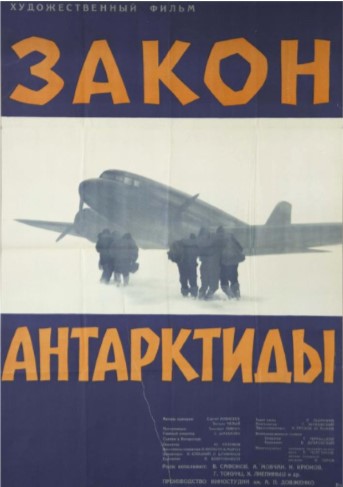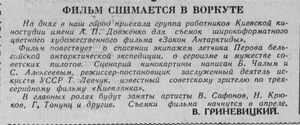The Law of Antarctica (lost Soviet film; 1962)
The Law of Antarctica (Russian: Закон Антарктиды) is a 1962 Soviet feature film that was directed by Tymofiy Levchuk and produced by Dovzhenko Film Studio.
Plot
Information about the genre of this film varies. According to Internet Movie Database[1] and Kinopoisk[2], the film is classified as action. However, the description more closely resembles that of an adventure film. Wikipedia categorizes the film as a drama based on a true story.
On the eve of the New Year, a Belgian plane carrying a group of Antarctic researchers crashed in the area of the Pearl Mountains. Only the Soviet expedition responded to their call for help. For several days, Soviet pilots, despite the weather conditions and risking their own lives, set out in search of the Belgians...[2]
The plot of the film is based on real events that took place in December 1958. The film, about human understanding, self-sacrifice, and friendship, tells the story of how Soviet polar pilots, for several days and in difficult weather conditions, risking their own lives, searched for and then rescued a group of Belgian polar explorers who had crashed in an airplane in the Antarctic ice[3].
Filming
The film was shot in Vorkuta, Komi ASSR. The 70-SK camera was used for filming[4].
Release
The film was theatrically released on January 18th, 1963. In its first year of release, it was watched by 3.5 million people[5]. The film also was released in Finland, Yugoslavia (Socialist Republic of Montenegro), Mexico and France. The screening of the film outside of the USSR indicates that it was a box office hit in its home country. It also was screened on TV on June 11th, 1968[6].
Availability
In Ukraine, the film was known as the first widescreen color film. Although the film was very popular outside the USSR, it is now practically unavailable online.












